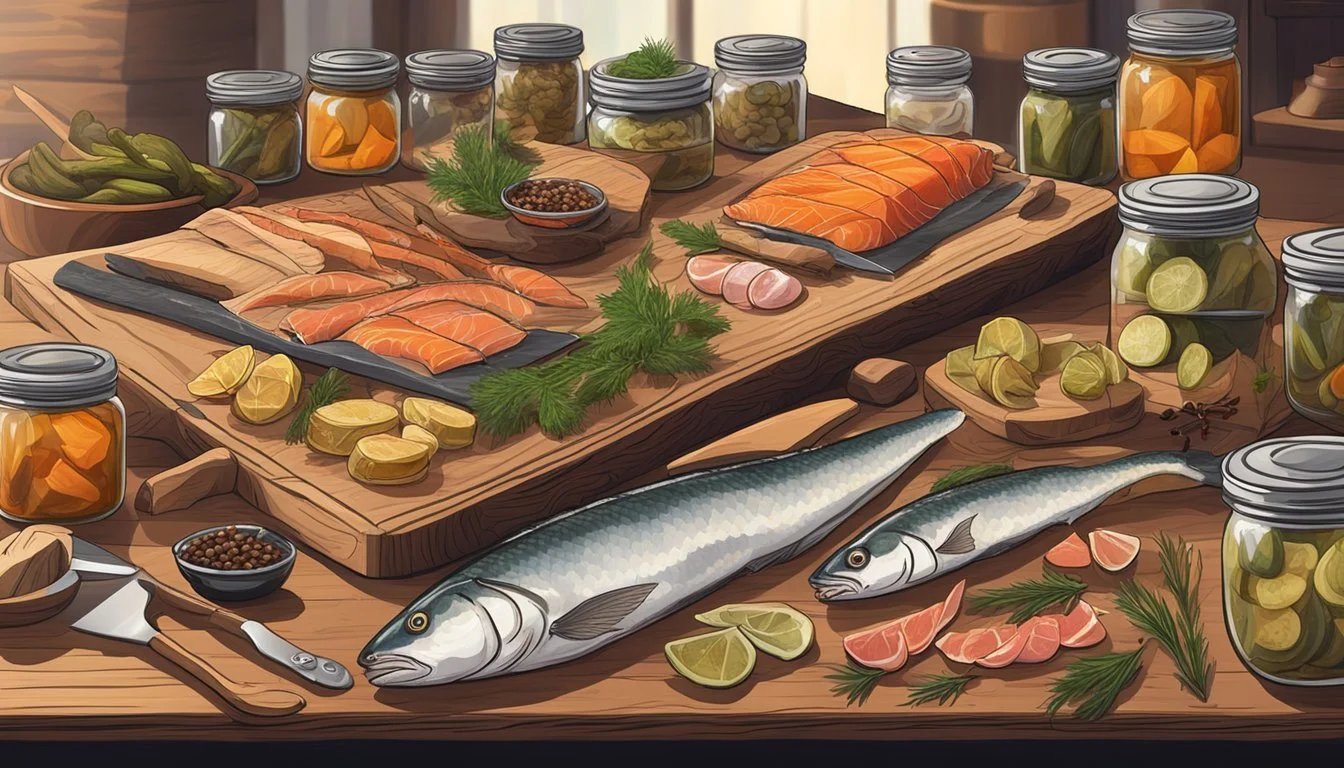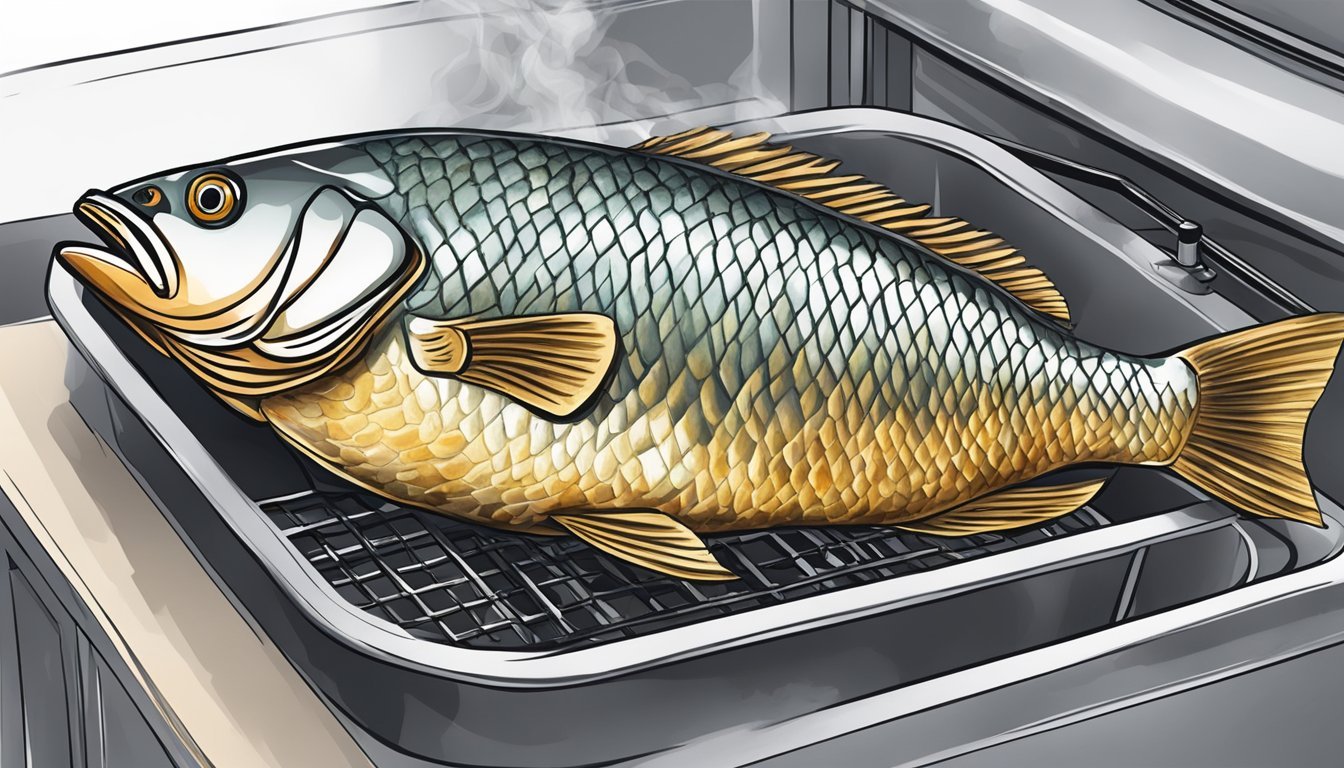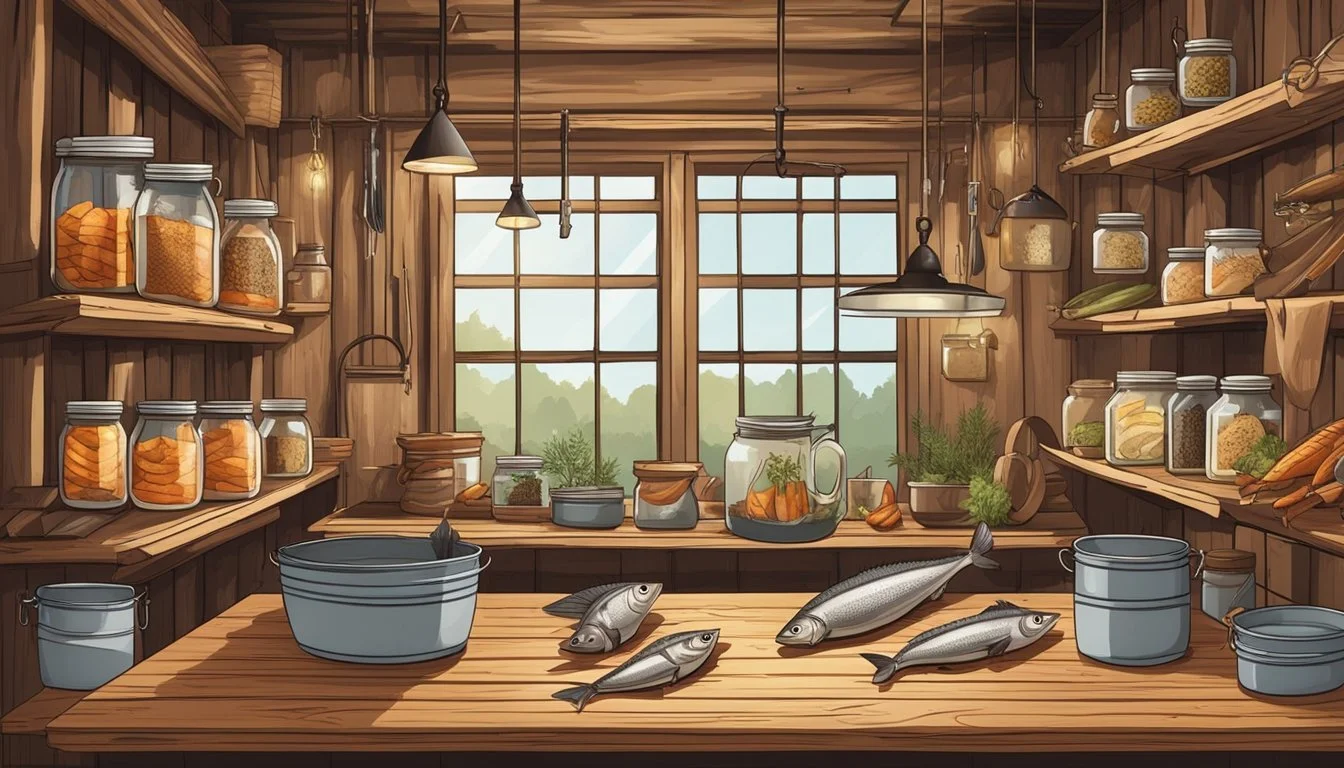Cured and Smoked Fish at Home
Your Ultimate DIY Preservation Manual
Curing and smoking fish at home is both an art and a science, offering a way to preserve the bounty of the sea while enhancing its natural flavors. The process of curing fish involves the use of salt, sugar, and sometimes smoke to not only extend the shelf life of the fish (What wine goes well with fish?) but also to impart a unique taste and texture. The basics involve a dry cure or brine, followed by a period of drying, and in the case of smoking, a controlled application of smoke. This age-old practice has been modernized with accessible techniques and equipment that allow home chefs to produce gourmet-quality seafood.
Creating cured and smoked fish requires patience and precision, ensuring that each step from preparation to final smoking is executed carefully. Home curing starts with selecting high-quality fish, typically salmon or trout due to their natural fat content which absorbs flavors well. A balance of kosher salt and sugar forms the foundation of the cure, which can be custom-blended with a variety of herbs and spices to suit individual tastes. After curing, smoking the fish at a low temperature infuses it with smoky nuances that can range from subtle to robust, depending on the type of wood chips used.
This comprehensive guide is designed to walk the reader through each phase of the curing and smoking process. It underscores the importance of timing, temperature control, and hygiene, ensuring food safety while achieving the desired culinary results. Whether opting for a cold smoking method to achieve a delicate, silky texture or a hot smoking technique for a firmer, more pronounced flavor, the guide provides clear, step-by-step instructions to ensure that even novices can produce exceptional home-cured smoked fish.
The Basics of Curing Fish
Curing fish at home elevates both its flavor and texture, transforming fresh fish into a savory delicacy. This process relies on careful ingredient selection and an understanding of the curing process itself.
Understanding the Curing Process
Curing is the act of preserving fish by drawing out moisture to extend its shelf life and to intensify its flavor. There are two primary techniques: dry curing and wet curing. Dry curing involves covering the fish with a mix of salt and sugar, while wet curing, or brining, submerges the fish in a solution of water, salt, and sugar. Both methods can include additional spices and flavorings. The interaction of salt and sugar not only preserves the fish but also enhances its natural flavors; additionally, the curing time adjusts the final texture of the cured fish.
Selecting the Right Fish
When choosing fish for curing, freshness is paramount. Popular choices include salmon, trout, and king salmon, known for their rich flavors and ample fat content which yields a luxurious texture after curing. Wild salmon varieties such as sockeye and coho are excellent for curing due to their firm texture. Wild Alaskan sockeye is particularly prized for its distinctive taste and texture. The size of the fish also matters; larger and fattier fish tend to absorb the cure better, resulting in a more pronounced flavor.
Essential Curing Ingredients
Salt: The cornerstone of curing, it's vital to use the right kind of salt. Kosher salt and sea salt are commonly used due to their pure flavors and coarse granules.
Sugar: Often used in combination with salt, sugar balances the cure's flavor. Brown sugar is frequently preferred for its molasses undertones.
Fresh Ingredients: Adding freshness to the curing process, elements like fresh dill, lemon slices, and other herbs and spices contribute to the unique character of the cured fish.
These ingredients, when used in proper proportions, interact to cure the fish, creating intricate flavors and an enjoyable firm texture, ready for smoking if desired, or to be enjoyed in its own right as cured fish.
Smoking Techniques and Equipment
When smoking fish at home, one must select the appropriate wood, set up the smoker or grill correctly, and decide between cold and hot smoking methods. Managing smoke and heat levels is crucial for ensuring both the safety and the quality of the finished product.
Choosing Your Wood
The type of wood used in smoking plays a significant role in the flavor profile of the fish. Commonly used woods include:
Oak: Offers a medium smoke flavor and pairs well with a variety of fish.
Alder: Traditional for smoking salmon due to its delicate, sweet flavor.
Hickory: Provides a stronger, heartier smoke taste.
Maple: Imparts a subtle sweetness, ideal for mild-flavored fish.
Cherry: Delivers a mild and fruity smoke, which complements lighter fish.
One should use wood chips or pellets designed for smoking to ensure consistent quality and flavor.
Setting up Your Smoker or Grill
Preparation of the smoker or grill dictates the success of the smoking process. For those using a grill, it requires a setup that allows for indirect heat, where the fish is placed away from the direct flame. In a smoker, the fish is positioned on racks over the heat source. Ensure a steady supply of wood chips to maintain consistent smoke.
Cold Smoking vs. Hot Smoking
Cold Smoking: This method involves smoking the fish at temperatures below 85°F (29°C). Cold smoking does not cook the fish, so it must be cured beforehand for safety. The process can take anywhere from several hours to days.
Hot Smoking: The internal temperature for hot smoking should be between 160-190°F (70-90°C). Hot smoking cooks and flavors the fish simultaneously. Before the fish is placed in the smoker, it's often left to form a pellicle, a tacky layer that allows smoke to adhere better.
Managing Smoke and Heat
Precise control of smoke and heat is essential in smoking fish. Use vents or dampers to manage airflow and stabilize temperature. Always monitor the internal temperature of the fish to ensure it reaches a safe level for consumption without overcooking. For hot smoking, one must achieve an internal temperature of around 145°F (63°C) to ensure the fish is safely cooked.
Brining and Seasoning
Perfectly cured and smoked fish is a complex balance of flavor and texture, achieved through two primary methods: dry and wet brine. The choice between them influences the taste and moisture of the final product, while the addition of flavors and aromatics can turn a simple piece of fish into a rich, aromatic delicacy.
Dry Brine vs. Wet Brine
Dry brining involves coating fish fillets with a mixture of salt, typically kosher salt, and sugar, often brown sugar, and sometimes including spices. This method draws out moisture through osmosis, concentrating the flavors. A common ratio is 3:1 of sugar to salt. The brined fish must be laid flat in a container and refrigerated. Salmon is a popular choice for dry brining, and the process can vary from a few hours to overnight, depending on the recipe and the size of the fillets.
Conversely, a wet brine consists of water combined with a high concentration of salt, sugar, and at times, spices. This solution needs to be thoroughly mixed until all solids are dissolved. The fish should be fully submerged in the wet brine and kept in the refrigerator, frequently ranging from 30 minutes to an hour for thin fillets. The wet brine not only seasons the fish but also can add moisture, resulting in a different texture from dry brining.
Adding Flavors and Aromatics
The curing process offers the opportunity to infuse the fish with a variety of flavors and aromatics, enhancing the overall taste. For a fragrant touch, fresh herbs such as dill or spices like black pepper and ground black pepper can be incorporated. The zest and slices of lemon provide a fresh, citrus note, and fresh herbs, onions, garlic, and even lemon zest can be added either in the dry rub or in the wet brine, offering deeper, more complex flavor profiles.
Fish enthusiasts often experiment with different combinations of aromatics to create unique and delicious results. As a general rule, one should carefully balance the flavors to complement the fish without overwhelming it, allowing the natural taste of fresh, quality fish to shine through.
Preparing Fish for Smoking
Before smoking, one must meticulously prepare the fish to enhance its flavor and texture. Proper cleaning, curing, and pellicle formation are essential to produce a moist, firm, and flavorful smoked fish.
Cleaning and Filleting
The fish should be fresh with bright eyes and firm flesh. For best results, it's recommended to clean the fish immediately after catching it. One should begin by scaling the fish, rinsing it thoroughly with cold water, and then patting it dry. The next step is to fillet the fish, removing the bones carefully to ensure the meat remains intact. Remove as much fat as possible since fat can become rancid during the smoking process.
Applying the Cure
The curing process involves a mix of salt and sugar, with a typical ratio being one part salt to three parts sugar. One can also add herbs, spices, and lemon slices for additional flavor. The cure should be applied liberally on the fillet, covering it entirely. It's then placed in a container or vacuum sealed and left in the refrigerator overnight. This step not only flavors the fish but also removes excess moisture, resulting in a firm texture.
Creating the Pellicle
After the fish has been cured, it must be rinsed with cold water to remove the cure's residue and then dried to form a pellicle—a tacky surface layer. This pellicle helps the smoke adhere better and prevents the surface from becoming too hard during smoking. The fish is left to air-dry, ideally in a cool place with good air circulation, until the surface feels sticky to the touch. This process can take several hours and is crucial for achieving the ideal texture in the finished product.
Smoking and Cooking
When smoking fish at home, precision in timing and temperature control is essential to achieve the perfect texture and flavor. The kind of wood used for smoke can offer a variety of subtle to robust flavors that enhance the fish's natural taste.
Timing and Temperature Control
Smoking salmon or other fish requires close attention to heat and time to preserve the delicate texture while imparting the smoky flavor. The ideal internal temperature for safely cooked fish is 145°F (63°C). To achieve this:
For hot smoking: Maintain a temperature range of 180°F to 220°F (82°C to 104°C).
For cold smoking: Keep temperatures below 85°F (29°C).
The cooking time varies depending on the thickness of the fish and the type of smoking:
Thin fillets: Approximately 1-2 hours
Thick fillets or whole fish: Can take several hours
A thermometer is essential to monitor the internal temperature and ensure food safety.
Flavor Enhancements with Smoke
The wood used for smoking directly impacts the final taste of the fish. Here is a guide to select wood that complements the flavor of smoked fish:
Milder woods: Alder or apple wood chips, which suit delicate fish like salmon
Stronger woods: Hickory or mesquite, which may overpower less robust fish
To use wood chips effectively during the smoking process:
Soak the wood chips in water for at least 30 minutes before use.
Drain and add them to the smoker or on top of the coals for charcoal grills.
Monitor the smoke's intensity as it infuses the fish.
For additional flavor profile, consider the following garnishes that can be added during the smoking process:
Fresh herbs: Dill or thyme
Citrus: Slices of lemon or orange
Spices: Peppercorns or coriander
Precision in both timing and choice of wood ensures a deliciously smoked fish with an optimal balance of smoke and flavor.
Storing and Serving Smoked Fish
Smoked fish preservation is critical for maintaining safety and flavor, while proper serving enhances the enjoyment of this delicacy among family and friends.
Proper Cooling and Storage
To ensure the safety and quality of smoked fish, it is imperative that it is stored correctly. After smoking, the fish should be allowed to cool completely. Once cooled, smoking fish should be wrapped tightly in plastic wrap or aluminum foil, or placed in an airtight container. In the refrigerator, smoked fish should be kept at a temperature below 40°F (4°C). This environment helps maintain the fish's texture and flavor.
For extended storage, freezing is advised. Here's how to properly freeze smoked fish:
Wrap the smoked fish tightly in plastic wrap, or place it in an airtight container to prevent freezer burn.
Label the package with the freezing date, to keep track of how long it has been stored.
Place the wrapped or containerized smoked fish in the freezer.
Remember, whether refrigerated or frozen, keeping smoked fish at the correct temperature is key for safety.
Delicious Serving Suggestions
When it comes to serving, smoked fish offers versatility that complements a variety of dishes. Here are several ways to serve smoked fish that can delight the palates of guests:
Smoked Salmon: Traditionally served on a bagel with cream cheese, garnished with capers, tomatoes, and onions.
Lox: A type of thinly sliced smoked salmon, often paired with herbs and salad for a light, flavorful dish.
With Crackers: Offer smoked fish as an appetizer with a selection of crackers, perfect for sharing among friends.
In Pasta or Rice: Flake the smoked fish into pasta or rice dishes for added richness in flavor and texture.
Fatty cuts of smoked fish are especially appreciated for their moist texture and enhanced richness when included in various dishes.
By adhering to these storage recommendations and serving suggestions, one can confidently enjoy the delicate flavors and nutritious benefits of smoked fish, from the rich protein content to the sumptuous taste that makes it a favorite at gatherings.
Advanced Techniques and Variations
In the realm of home-smoked and cured fish, a number of advanced techniques can elevate the end product. Enthusiasts may choose to vary fish types, curing mixes, and wood flavors to create distinct, gourmet results.
Exploring Different Fish Species
Selecting different fish species allows one to experiment with varying levels of fat and protein content, which influence the texture and flavor. Pacific Northwest fish such as King salmon, Sockeye, and Coho are prized for their rich, fatty qualities. Trout, with its leaner profile, presents a subtly different base for smoking and curing. Hearty fish like mackerel and herring stand up well to bolder smoke flavors.
King Salmon: High in fat, robust flavor
Sockeye: Deep red color, distinct taste
Coho: Milder flavor, medium fat content
Trout: Lean protein, delicately flavored
Experimenting with Cure Mixes
A cure typically begins with a foundation of salt and sugar. However, incorporating additional ingredients such as light brown sugar for a molasses note or kosher salt for its coarser grains can affect both texture and taste. The cure can be further enhanced with a variety of spices, herby notes from gin, or the tannic qualities of tea and wine.
Cure Mix Variations:
Classic Mix: 1 part kosher salt to 1 part sugar—simple and traditional.
Herbal Twist: Add juniper berries and dill for a Scandinavian touch.
Boozy Cure: Use gin or wine to impart complex aromatics.
Infusing Unique Wood Flavors
The type of wood used in smoking is pivotal to the flavoring process, as each wood variety imparts a distinct aroma and taste to the fish.
Wood Type Flavor Profile Oak Strong, versatile smoke flavor Alder Traditional for salmon; mild Hickory Bold, bacon-like flavor Maple Sweet, subtle smokiness Cherry Fruity, sweet notes Apple Lightly sweet, fruity tang
Experimenting with wood types like cherry for a milder, sweeter smoke or hickory for a robust profile allows the preparer to customize the final flavor. Different woods can also be combined to create a more complex flavor profile.
Safety Considerations and Best Practices
When curing and smoking fish at home, ensuring food safety is paramount to prevent illness. Proper salting—known as the curing process—is crucial, as it inhibits the growth of bacteria. Salt should be used according to the recipe to achieve the desired safety and flavor.
Temperature control is another essential aspect of food safety. The smoking process involves either low temperature smoke or hot smoke. For cold smoking, temperatures generally range between 68°F and 86°F, and can last for several hours to days, requiring a well-maintained smoke environment. The cold process does not cook the fish, so it must be cured adequately before smoking to ensure safety.
In hot smoking, temperatures range from 126°F to 176°F, which cooks the fish during the smoking process. Fish should reach an internal temperature of 145°F to ensure it's safe to consume.
A pellicle, a sticky surface layer that forms after curing, aids in the adherence of smoke particles and helps protect the fish from harsh heat elements. It's important to allow the pellicle to form before smoking by air-drying the fish, often in a refrigerator for optimal safety.
During the entire process, one must keep the fish at safe temperatures to prevent bacterial growth. If the recipe calls for fresh herbs or other additives, they should be fresh and handled appropriately to avoid contamination.
Remember, storing the smoked fish in containers inside a refrigerator is essential for maintaining safety post-smoking. Moreover, always use reliable temperature indicators or probes to monitor the conditions accurately.
In summary, adhere meticulously to temperature guidelines, curing recipes, and storage instructions to enjoy home-smoked fish safely.





